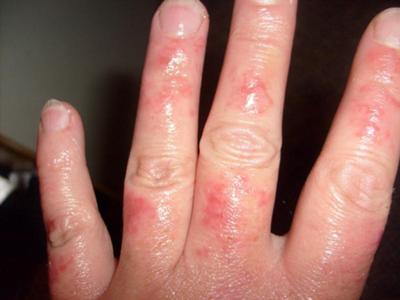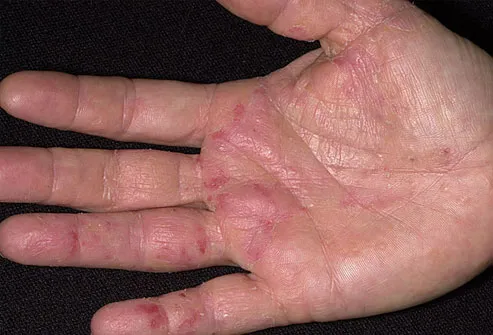Skin Rashes On Hands Biography
Source(google.com.pk)There are two types of skin rashes, namely infectious and non-infectious rashes. Most health care professionals are of the opinion that one should not be in a hurry to treat symptoms of rashes like dry skin, itching, etc. immediately. Many times, the body is able to treat rash on its own and one does not have to bother about treating the same. The most commonly observed characteristic of rash is redness, itching and small elevation on the affected area. The appearance of the rash may either be flaky, scaly or bumpy and in some cases, it may also be filled with pus.
Possible Causes
There are numerous causes of skin rashes on different parts of the body. The cause of a skin rash is determined from the characteristics it displays and other symptoms seen along with the rash. Inflammation of the skin is referred to as dermatitis or simply skin rash. The rash on the hand is called skin dermatitis or hand eczema. This condition is usually caused when the person comes in contact with a certain irritant, to which the person is allergic to. The common allergens or irritants are:
Chemicals present in rubber, elastic or latex products.
Certain ingredients in soaps, detergents and cosmetics.
Chemicals, solvents and dyes used in various industries.
Some metals can also give rise to skin rashes.
Trees and plants like poison ivy, poison oak, certain kinds of grass, etc.
The rash can by caused as an effect of psoriasis, shingles (chickenpox causing virus), and insect bites.
Professionals who come in frequent contact with wet or irritating substances, like cleaning fluids, different chemicals and metals or who wash their hands frequently are the ones who suffer from this condition often. Certain substances present in these irritants cause the breaking down of the natural barrier of protection, which causes skin rashes.
Symptoms
» Itchy rash ranging from mild to severe in intensity, sometimes shows swelling and blistering, which are the most common symptoms of skin rashes.
» Often, extreme itching causes sores, which then results in bacterial infections.
» If the skin rashes are caused by a fungal infection, itchy blisters along the sides of fingers is a common symptom. Contact dermatitis caused due to irritants or allergens is seen on the top of the hand. The skin on top of the hands appears dry and chapped, especially around the knuckles and on top of fingers.
» When the irritant is a metal, it gives rise to irritation under the ring.
» If the skin rash is caused due to poisonous plants, it causes blistering and weeping of rash.
» Red scaling eruptions seen on the brows, cheeks, forehead, scalp and external ears is a symptom of seborrheic dermatitis.
» After prolonged exposure to certain substance, a person can develop allergy to the said substance, which leads to eruption of rashes.
Treatment Measures
To treat skin rashes on arms and hands, the first step, you should undertake, is to find out what is that which irritates your skin. In other words, find the irritant or allergen. Once you have found the irritant, make sure that you do not come in contact with it. You will have to visit your health care professional to get the right treatment for your skin condition, if you are not able to locate the irritant. More often than not, your physician will prescribe over the counter available topical application ointments. These ointments will help in relieving you of itching and irritation. If the topical application does not help, the physician may have to prescribe antihistamines or oral corticosteroids. If the skin rash is caused by bacteria, you will have to undergo a dose of antibiotics.
It is advisable not to scratch or scrub your skin, when there is an eruption on the hands. If at all you do scratch the affected part, wash your hands immediately, so that the rash does not spread to other parts of the body. Use gentle cleansers instead of soaps to wash your hands. Do not use cosmetics directly on the skin rash. In case you are using a new cosmetic, remove it from your daily use, as there are chances of it aggravating the condition. Do not cover the area affected with skin rashes. Leave the area exposed to air as much as possible, and make use calamine to soothe the skin.
Some tips to avoid any such further skin rashes on hands are to avoid the allergens as far as possible. In case you do come in contact with the allergens like poisonous plants, etc. make sure you wash your hands well with soap and water. If you come in frequent contact with water, chemicals, cold or friction, wear the right kind of gloves to protect your hands.










please advice a treatment for this kind of allergy.. and what are the precautions.
ReplyDeleteplease advice a treatment for this kind of allergy.. and what are the precautions.
ReplyDeleteI've got hands like these. I've had eczema on my hands and now on my feet. Started about two years ago.
ReplyDeleteI'm finding an elimination diet is proven to show some promises.
I worked on removing gluten, it help, started to see changes straight away. Then I worked on a theory about itchy foods and removed some foods such as tomato, onion, chillies, green leafy vegetable and many fruit. I found that when I reintroduced that I was prickly and itchy and my eczema flared up. I have been removing process foods from my diet, every thing I make is fresh. I'm not cured still early days but I think I'm onto something. All I can say is give it a go, start with one of two suspected foods first rather than eliminating everything all at once (it's an emotional adjustment to removing a suspected food that your used to having in your diet or that you love eating. There are usually signs with in one to two weeks, but I have read that a suspected allergen takes at least a month to cause the intensive rash and itching and may take as long for the impact of the flare to resolve. A diet regime will take time, with adjustments etc. If nothing else, it could result in reduction and severity of eczema and allergy symptoms.